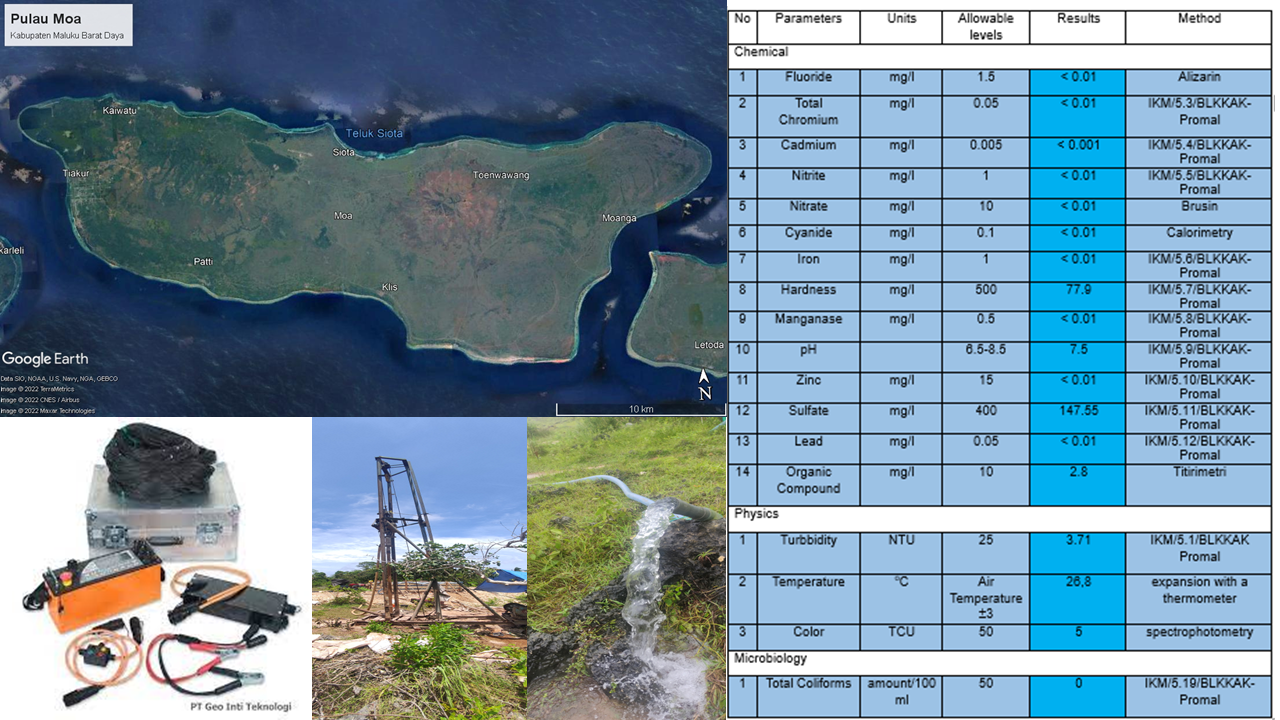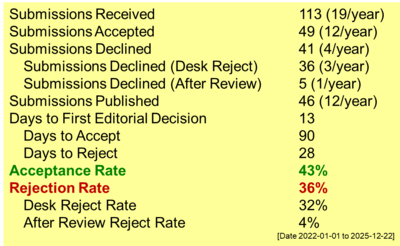Chemicals Analysis of Drilled Ground Waters in Moa Island, Maluku, Indonesia
DOI:
https://doi.org/10.55749/ijcs.v2i2.36Keywords:
Chemical parameters, Drilled ground water, Microbiological parameters, Physical parametersAbstract
Moa Island is one of the remote Indonesian Islands that face the difficulty in accessing clean water, especially during the dry season. One way to get clean water is by drilling for groundwater. The drilled groundwater in Kaiwatu Village on Moa Island, Southwest Maluku Regency, Maluku Province, was analyzed for its content to obtain primary data. Primary data related to the quality of drilled groundwater sources includes chemical, physical, and microbiological parameters. The results of chemical parameters obtained from the test results were <0.01 mg/L fluoride, total chromium, nitrite, nitrate, iron, manganese, zinc, cyanide, lead, <0,001 mg/L cadmium, 17.9 mg/L hardness, sulfate 147.55 mg/L, pH 7.50, and organic substances 2.8 mg/L. The physical parameter analysis showed a turbidity level of 3.71 NTU, a temperature of 26.8 °C, and a color of 5 TCU. The microbiological parameters obtained by the analysis were 0/100 mL. Primary data was then compared with secondary data, namely environmental health quality standards and air health requirements from Minister of Health Regulation No. 32 of 2017 for chemical and physical parameters, as well as water quality requirements and monitoring from Minister of Health Regulation 416/MENKES/IX/1990 for microbiological parameters. The analysis results using a comparison of primary and secondary data showed that all parameters contained in the primary data had values below the safe limits set by the requirements in the secondary data.
References
Arnop, O., Budiyanto, B., & Saefuddin, R. 2019. Kajian evaluasi mutu sungai nelas dengan metode Storet dan indeks pencemaran. Naturalis. 8(1), 15–24. https://doi.org/10.31186/naturalis.8.1.9158.
Mbarep, D. P. P., Apelabi, G. O., Bolly, Y. Y., & Nurhidayat, A. 2022. The potency of obtained clean water from rainwater harvesting in sikka regency. Journal of Nat. Res. Env.Man. 12(2), 237–245. https://doi.org/10.29244/jpsl.12.2.237-245.
Imamuddin, M., & Hidayat, A. 2021. Utilization of made aquifers to improve the quality of clean water to drinking water. Int. J. Civ. Eng. Inf., 1(2), 6-9. https://doi.org/10.24853/ijcei.1.2.6-9.
BPS-Statistics of Maluku Barat Daya Regency. 2021. Kecamatan Moa dalam angka (Moa subregency in figures). BPS-Statistics of Maluku Barat Daya Regency.
Patty, C., Loris, J., & Siwa I. 2007. Inventarisasi hijauan makanan ternak lokal di pulau Moa. In Proceeding of National Seminar “akselerasi inovasi teknologi pertanian spesifik lokasi mendukung ketahanan pangan di wilayah kepulauan”. BPTP Maluku–Pemerintah Provinsi Maluku–Universitas Pattimura. pp. 809-814.
Public Relation of Secretariat Cabinet Republic Indonesia. 2022. Presiden serap aspirasi peternak kerbau di pulau moa soal kesulitan air. Https://Setkab.Go.Id/Presiden-Serap-Aspirasi-Peternak-Kerbau-Di-Pulau-Moa-Soal-Kesulitan-Air/.
Supriyadi, Susilo, Sunaro, & Setyawan. 2012. Pemodelan fisik aplikasi metode geolistrik konfigurasi Schlumberger untuk mendeteksi keberadaan air tanah. Indones. J. Math. Nat. Sci. 35(1), 38–45. https://doi.org/10.15294/ijmns.v35i1.2095.
Wahyuningrum, N. & Susanti, P. D. 2020. Identification of the main water quality parameters for monitoring and evaluating watershed health. Indones. J. Geogr. 52(2), 228 – 238. https://doi.org/10.22146/ijg.47280.
Latupeirissa A. N. & Latupeirissa J. 2022. Analysis of physical and chemical quality of PDAM water in Teluk Ambon Baguala Sub-District. J. Penelitian Pendidikan IPA. 8(3), 1314 – 1319. https://doi.org/10.29303/jppipa.v8i3.1535.
Haftu, Z., Estifanos, S. 2020. Investigation of physico-chemical characteristics and heavy metals concentration implying to the effect of local geology on surface water quality of Werii catchment, Tigray, Ethiopia. EQA–Int. J. Environ. Qual. 40, 11–18. https://doi.org/10.6092/issn.2281-4485/10602.
Qibtia, A., Maharani, M., & Noviana, L. 2021. Uji kandungan parameter kimia air tanah di sekitar tempat penampungan sementara untuk kebutuhan air bersih (studi kasus: tps perumahan x). Sus. Environ. Opt. Ind. 3(2), 16–32. https://doi.org/10.36441/seoi.v3i2.441.
Herdini, Hadi, V., & Trianisa Novalina. 2023. Analisis kesadahan total (CaCO3), kalsium (Ca2+), magnesium (Mg2+) pada air sumur tanah di Jakarta Utara. Teknosains. 10(1), 1–11. https://doi.org/10.37373/tekno.v10i1.192.
Jannah, Z. N., Herawati, D., & Ngibad, K. 2021. Review: analisis konsentrasi ion sulfat dalam air menggunakan spektrofotometri. J. Pijar Mipa. 16(2), 203–206. https://doi.org/10.29303/jpm.v16i2.1907.
Apriyanti, A., & Apriyani, E. M. 2019. Analisis kadar zat organik pada air sumur warga sekitar tpa dengan metode titrasi permanganometri. Alkimia. 2(2), 10–14. https://doi.org/10.19109/alkimia.v2i2.2988.
Rinda, R., Salakory, M., & Leuwol, F. S. 2022. Analisis kualitas dan kuantitas air sumur gali di dusun pulau osi kecamatan seram barat kabupaten seram bagian barat. J. Pend. Geogr. Unpatti. 1(1), 47–59. https://doi.org/10.30598/jpguvol1iss1pp47-59.
Handriyani, K. A. T. S., Habibah, N., & Dhyanaputri, I. G. A. S. 2020. Analisis kadar timbal (pb) pada air sumur gali di kawasan tempat pembuangan akhir sampah Banjar Suwung Batan Kendal Denpasar Selatan. JST (Jurnal Sains Dan Teknologi), 9(1), 68–75. https://doi.org/10.23887/jstundiksha.v9i1.17842.
Rohmawati, Y., & Kustomo, K. 2020. Analisis Kualitas Air pada Reservoir PDAM Kota Semarang menggunakan uji parameter fisika, kimia, dan mikrobiologi, serta dikombinasikan dengan analisis kemometri. Walisongo J. Chem. 3(2), 100-107. https://doi.org/10.21580/wjc.v3i2.6603.
Santoso, A. I., Azhari, M., & Putro, D. S. 2023. Analysis of the impact of handwashing with soap policy on water quality in public facilities: a case study in palangka raya, Indonesia. Indones. J. Chem. Stud. 2(2), 35-40. https://doi.org/10.55749/ijcs.v2i2.27.
Syamsussabri, M., Ningtyas, R. N., Najah, A. A., Fahmi, M. S., & Suarsini, E. 2018. Analysis of coliform bacteria contamination in drinking water sources in Malang City. El-Hayah. 7(1), 28-35. https://doi.org/10.18860/elha.v7i1.7244.
Bai, V. R., Kit, A. C., Kangadharan, G. Gopinath, R., Varadarajan, P., Hao, A. J. 2022. Experimental study on total coliform violations in the complied NH2CL, O3, and UV treated municipal water supply system. Eur. Phys. J. Plus. 137 (689), 1-18. https://doi.org/10.1140/epjp/s13360-022-02891-5 .

Downloads
Published
How to Cite
Issue
Section
License
Copyright (c) 2023 Indonesian Journal of Chemical Studies

This work is licensed under a Creative Commons Attribution-ShareAlike 4.0 International License.






















